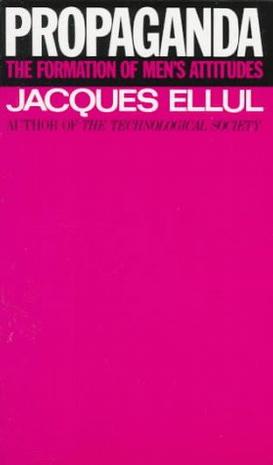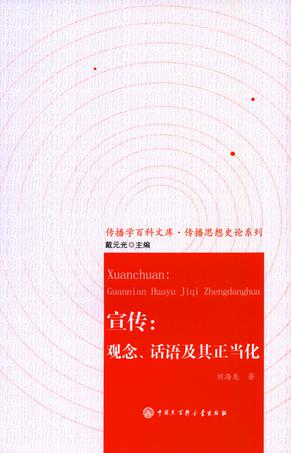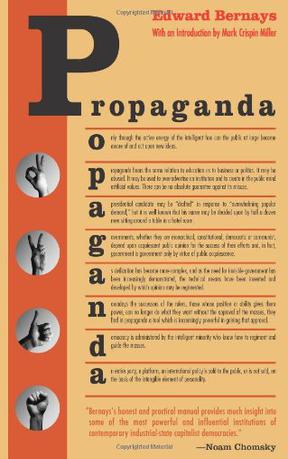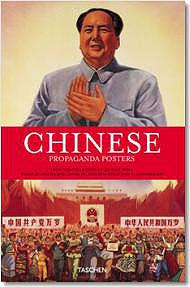-

Propaganda
-

宣传
本书是宣传概念的历史,也是宣传观念的历史。为了回答什么是宣传、它为什么会存在、大众为什么会容忍宣传等问题,本书追溯了第一次世界大战中宣传概念的产生、美国20世纪初宣传与民主的争论、俄国革命的宣传观念、第二次世界大战中的宣传观念、二十世纪后期的新宣传等宣传观念发展的重要环节,并以此为背景,重点研究了中国宣传观念的产生、国民党及共产党宣传观念的建立、知识分子与宣传、1949年之后中国宣传观念的变迁等问题。本书以理性中立的笔调,详细描述了二十世纪以来各种宣传观念和话语的交锋,展示了一幅国家与个人、控制与自由、思想与身体等观念相互冲突的全景图像。本书提出的问题值得每个深受宣传影响的中国人思考。 -

Propaganda
“Bernays’ honest and practical manual provides much insight into some of the most powerful and influential institutions of contemporary industrial state capitalist democracies.”—Noam Chomsky “The conscious and intelligent manipulation of the organized habits and opinions of the masses is an important element in democratic society. Those who manipulate this unseen mechanism of society constitute an invisible government which is the true ruling power of our country.”—Edward Bernays, Propaganda A seminal and controversial figure in the history of political thought and public relations, Edward Bernays (1891–1995), pioneered the scientific technique of shaping and manipulating public opinion, which he famously dubbed “engineering of consent.” During World War I, he was an integral part of the U.S. Committee on Public Information (CPI), a powerful propaganda apparatus that was mobilized to package, advertise and sell the war to the American people as one that would “Make the World Safe for Democracy.” The CPI would become the blueprint in which marketing strategies for future wars would be based upon. Bernays applied the techniques he had learned in the CPI and, incorporating some of the ideas of Walter Lipmann, became an outspoken proponent of propaganda as a tool for democratic and corporate manipulation of the population. His 1928 bombshell Propaganda lays out his eerily prescient vision for using propaganda to regiment the collective mind in a variety of areas, including government, politics, art, science and education. To read this book today is to frightfully comprehend what our contemporary institutions of government and business have become in regards to organized manipulation of the masses. This is the first reprint of Propaganda in over 30 years and features an introduction by Mark Crispin Miller, author of The Bush Dyslexicon: Observations on a National Disorder. -

Chinese Propaganda Posters
The Communist superhero With his smooth, warm, red face which radiated light in all directions, Chairman Mao Zedong was a fixture in Chinese propaganda posters produced between the birth of the People’s Republic in 1949 and the early 1980s. These infamous posters were, in turn, central fixtures in Chinese homes, railway stations, schools, journals, magazines, and just about anywhere else where people were likely to see them. Chairman Mao, portrayed as a stoic superhero (a.k.a. the Great Teacher, the Great Leader, the Great Helmsman, the Supreme Commander), appeared in all kinds of situations (inspecting factories, smoking a cigarette with peasant workers, standing by the Yangzi River in a bathrobe, presiding over the bow of a ship, or floating over a sea of red flags), flanked by strong, healthy, ageless men and “masculinized” women and children wearing baggy, sexless, drab clothing. The goal of each poster was to show the Chinese people what sort of behavior was considered morally correct and how great the future of Communist China would be if everyone followed the same path toward utopia by uniting together. Combining fact and fiction in a way typical of propaganda art, these posters exuded positive vibes and seemed to suggest that Mao was an omnipresent force that would accompany China to happiness and greatness. This book brings together a selection of colorful propaganda artworks and cultural artifacts from photographer Michael Wolf’s vast collection of Chinese propaganda posters, many of which are now extremely rare.